Open only to WEAD listing artists and members, each Portfolio is curated by the Editorial Committee to showcase artists whose work reflects diverse approaches to environmental and social justice art.
ARTISTS
Jane Ingram Allen
Salma Arastu
Stephanie Garon
Linda Gass
Linda MacDonald
Nancy Peluso
Ann Savageau
Jane Skafte
Ruth Tabancay
JANE INGRAM ALLEN
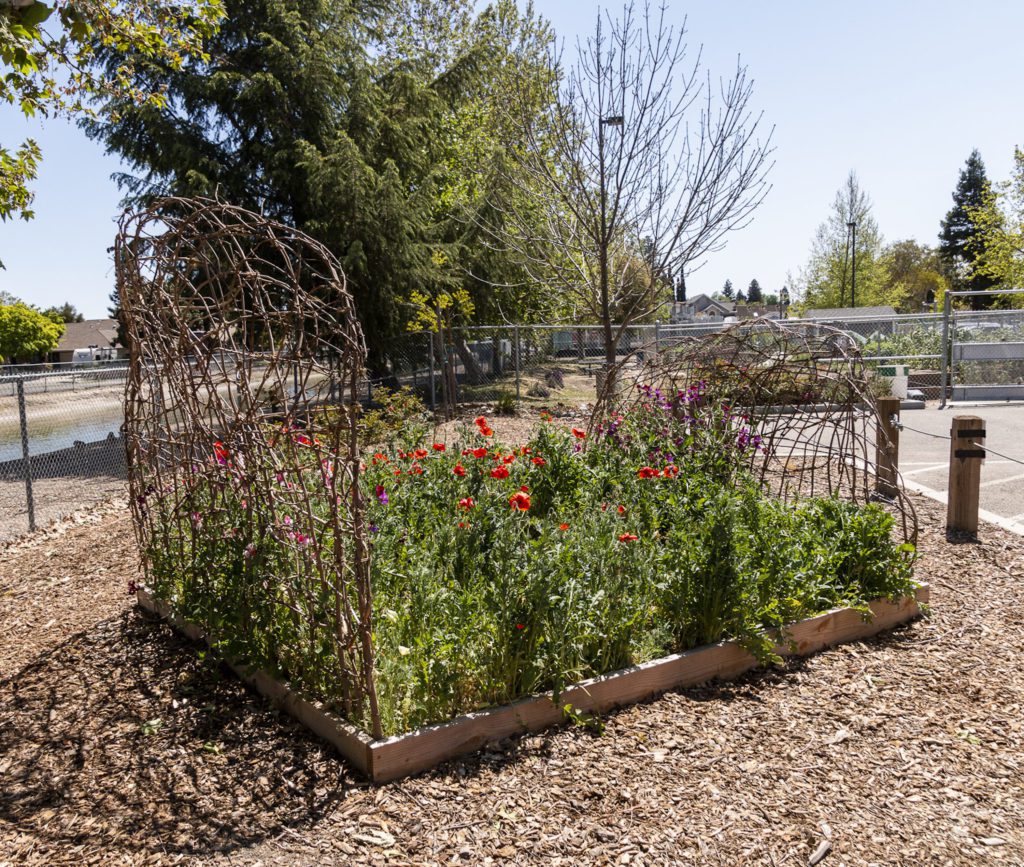
Jane Ingram Allen, ‘Living Quilt for Sojourner Truth’, shown on April 12, 2021, 8 feet x 10 feet x 6 feet, installed at Sojourner Truth Park, Sacramento, CA, in November 2020 to change over time. Photo: Timothy S. Allen
SALMA ARASTU
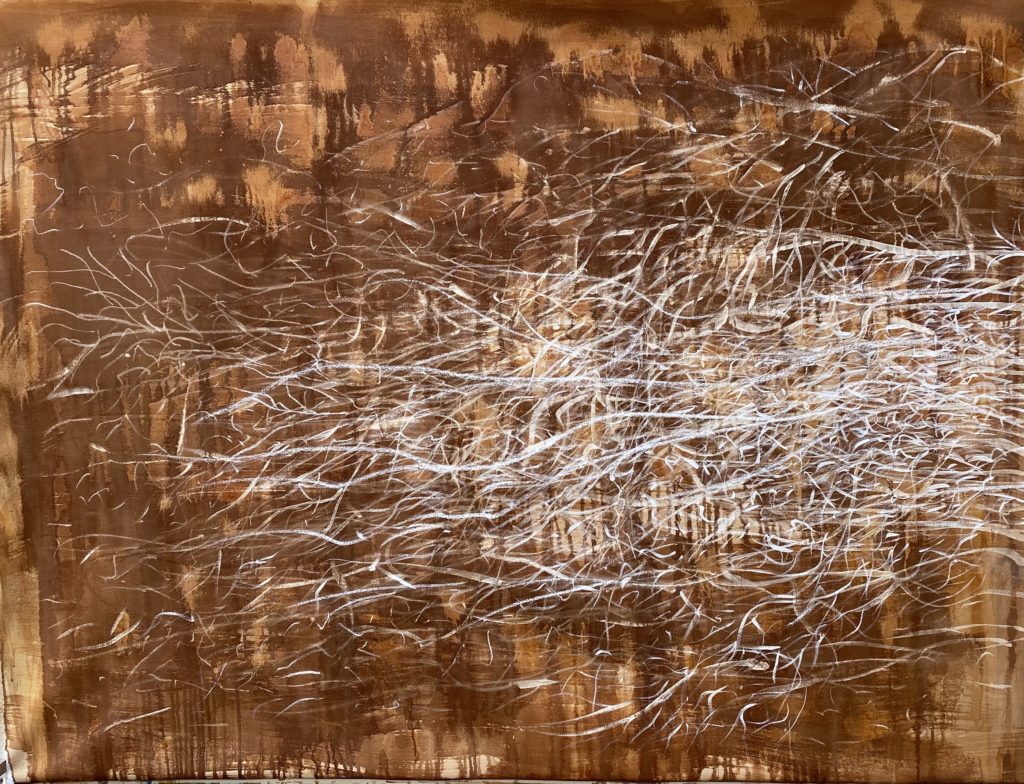
MYCELIA: DECAY AND REGENERATION
Mycelial Flow, Energy and Hope from underground
These are my paintings from my new series which I began recently. I have found myself immersing myself in deeper knowledge to find remedies to save our planet and its ecosystems. And I have discovered Mycelia- the vegetative part of a fungus, consisting of a network of fine white filaments. A new ray of hope is rising from the mushrooms and underground network of mycelia to regenerate, activate, and heal the damaged state of our environment.
The energy, movement, and purpose of these spreading energies underground suit my direction of finding hope and their speedy growth suits my moving lyrical lines. I am painting with rust and acrylics and oil pastels and applying final glaze to seal everything. I am enjoying my process.
STEPHANIE GARON
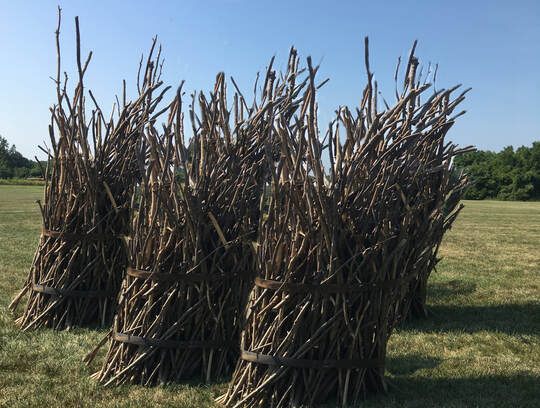
LAMENT, Steel, oak/maple/pine sticks (14’x14’x8′ ) Women around the world, from Bangladesh to Benin, carry bundles of sticks to support their community. Confined by land and ritualistic roles, Lament references women’s work.
As a five year old, I tagged along with my father to “hamfests,’ radio operator gatherings held in county fair parking lots. Cars would pop open their trunks like overflowing treasure chests filled with electronic wares: old radio boxes, computer boards, cables, monitors, soldering irons. It was an oasis in the heart of wooded valleys. Years later, when I’m welding and smelling the rusty steel odor of the studio, I am driving down those dusty roads again.
My artwork investigates the vulnerability of nature to humanity. The juxtaposition of natural objects against industrial materials exposes dichotomies of formality/fragility and permanence/impermanence. The natural materials, sourced by hand locally, convey themes of claim, women’s labor, and time.
While formal, the resulting artworks are ecologically motivated interventions. The physical process of decomposition becomes evident as the pieces change over time, emphasizing the fragility of nature. These abstracted expressions visualize an uneasy truce. A contemporary twist on the Arte Povera movement, my work addresses climate crisis politics, and mediates attention to the materials themselves.
Whether the viewer is immersed in a large scale installation or navigating their movement around a sculpture, the contemplative space created engages the observer to consider how we, as people, interrupt the natural world around us.
LINDA GASS

Hard and Soft: Rendering Salt, Restoration Alchemy, Reseeding Wetlands 2018, Silk crepe de chine, silk dyes, water soluble resist, Lutradur, polyester batting, rayon/viscose
This 6-part series pairs three glass works with three textile works, representing a progression of industrial salt ponds being restored back into wetlands. Many of the wetlands in San Francisco Bay were destroyed to build ponds for industrial salt extraction. Restoration efforts over the past couple of decades are beginning to transform the salt ponds back into wetlands. My work explores how landscapes change over time focusing on those places where destruction and renewal, wounding and healing, absence and presence overlap. The artwork pair on the left show an industrial salt extraction pond as the salty remains of a dead wetland. The artwork pair in the middle represent the process of restoration, using the metaphor of alchemy and its transformation of matter. The artwork pair on the right represent the restored wetlands, verdant with life.
LINDA MACDONALD
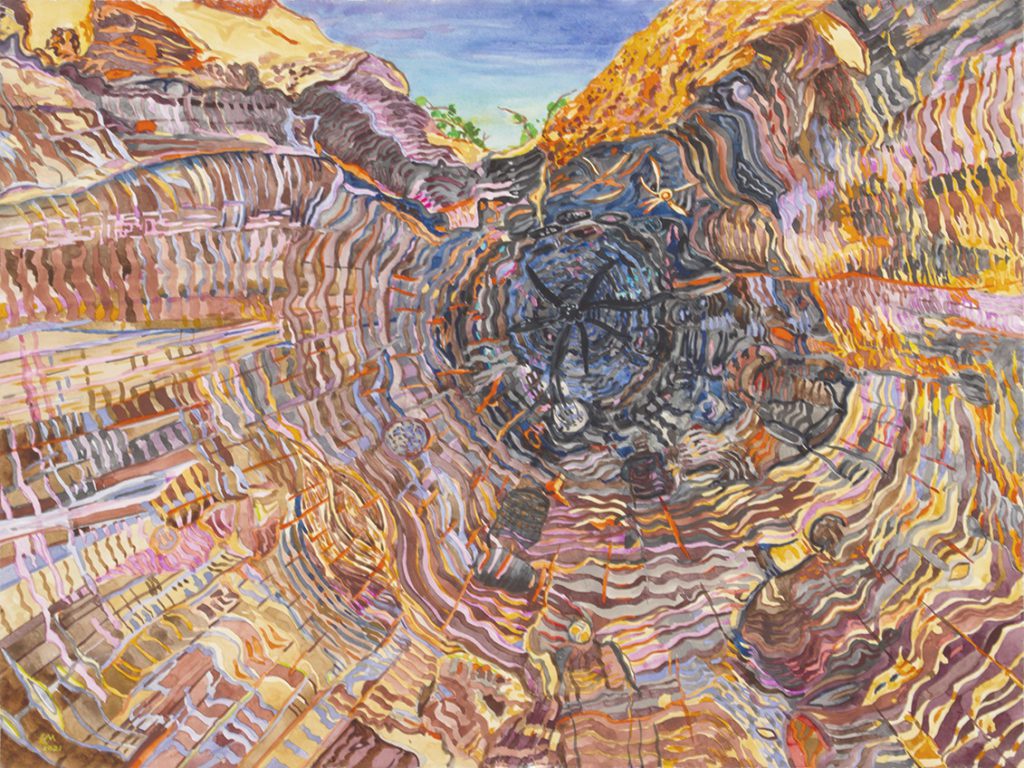
LOOK UP, IN AND OUT—Grizzly Creek Redwoods
Sequoia Sempervirens and Sequoia Gigantica are the two types of redwoods unique in the California ecosystem. They are the State’s official tree and a symbol of longevity. Logging is still the biggest threat to the redwoods. Ninety-five percent of all redwoods, Coast and Sequoia, have been cut since 1850. Most of what is left are on public lands. Redwood lumber is still being milled for use in construction and mainly for outdoor decks and fencing, but also exported to other countries. There are good substitutes for redwood decking, such as synthetics and other lumber varieties. Redwoods collect fog, cool streams, create habitat for fish and animals, provide forest environment, slow the desertification of the land, inhale carbon dioxide and breathe out oxygen. We must allow the amazing redwoods to live to a ripe old age.
I like to visit as many groves as I can and photograph how unique and amazing they are. The burned out giants are symbols of resilience, longevity and healing during troubling times. As a painter I am attracted to the shapes of their interiors, the colors and textures, their sizes and revealed history. After going into the burned out interiors, I photograph them. Back in the studio, I paint these interior views that portray their burned areas and sculpted shapes. Beauty in art is important in attracting viewers who will take the time to ponder the dilemmas of over-harvesting, redwood usage and preservation. My hope is that people will visit the groves and choose to help in preservation by joining the many organizations, such as Save Our Redwoods League, Sierra Club, National Park Foundation, and many others. Also, I hope everyone will be moved to visit the amazing redwood groves.
NANCY PELUSO
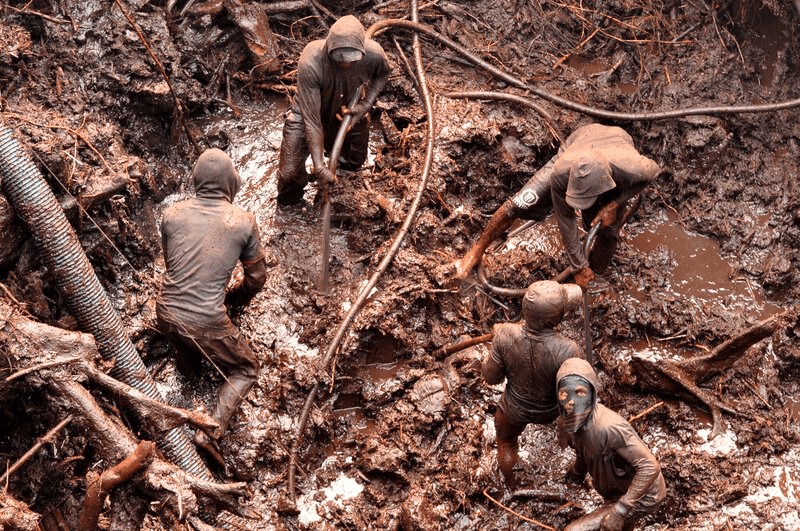
THE LOOK, Nancy Peluso, West Kalimantan, 2015.
“The Look” was taken in 2015 in the Ketapang region of West Kalimantan (Indonesian Borneo). They document laborers involved in small-scale gold mining and the work involved in the transformation of what was once a rainforest.
These mining laborers hail from regions known for their mixed farming and mining landscapes. Many are forced into this dirty work because of the low prices of the commodity crops they grow at home: rubber, rice, corn, and fruit. Others see no future for themselves in agrarian livelihoods.
Peluso, a professor of political ecology at UC Berkeley, has researched smallholders, workers, and land transformations in Indonesia for more than 35 years; she is a Guggenheim fellow and holder of the 2019 Al Moumin Environmental Peacebuilding Award.
Peluso’s photographs were taken in the course of her ethnographic fieldwork and during a Fulbright senior scholar fellowship in 2015. David Gilbert printed and framed these photos in 2021. They are part of a larger, virtual exhibit hosted by UC Berkeley’s Environmental Design Library curated by Peluso, David Eifler, and Katie Riddle. The more than 100 photos in that exhibit focus on miners’ labor and lives, their working landscapes, and their life-or-death dependence on each other every time they enter a mining pit or tunnel.
You can find that exhibit at : https://exhibits.lib.berkeley.edu/spotlight/gold-farmers
ANN SAVAGEAU
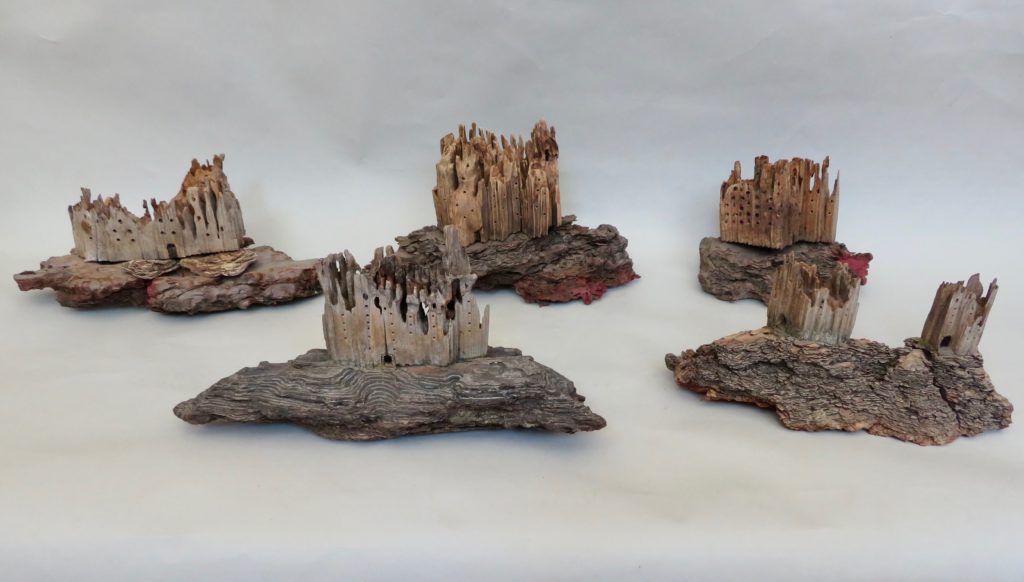
RUINED FORTRESSES. Photo: Ann Savageau
Since 2010, 129 million trees have died in California’s national forests, due to the drought
that weakens the trees, leaving them susceptible to bark beetles. Trees are sheathed in protective bark, serving a function similar to a fortress wall. When that wall is breached, the attackers, aka bark beetles, can enter the tree and kill it.
I have been collecting pieces of decomposing wood from the stumps of Sierra Nevada trees that died and were cut down. Beetles and fungi carve these pieces into shapes that bear an uncanny resemblance to ruined fortresses and castles. Each one is a microcosm of the larger environmental disaster facing us. I am mounting them on pieces of the bark from the same trees, and I plan to make enough of these to present in an installation to raise public awareness about what is happening to our forests.
JANE SKAFTE
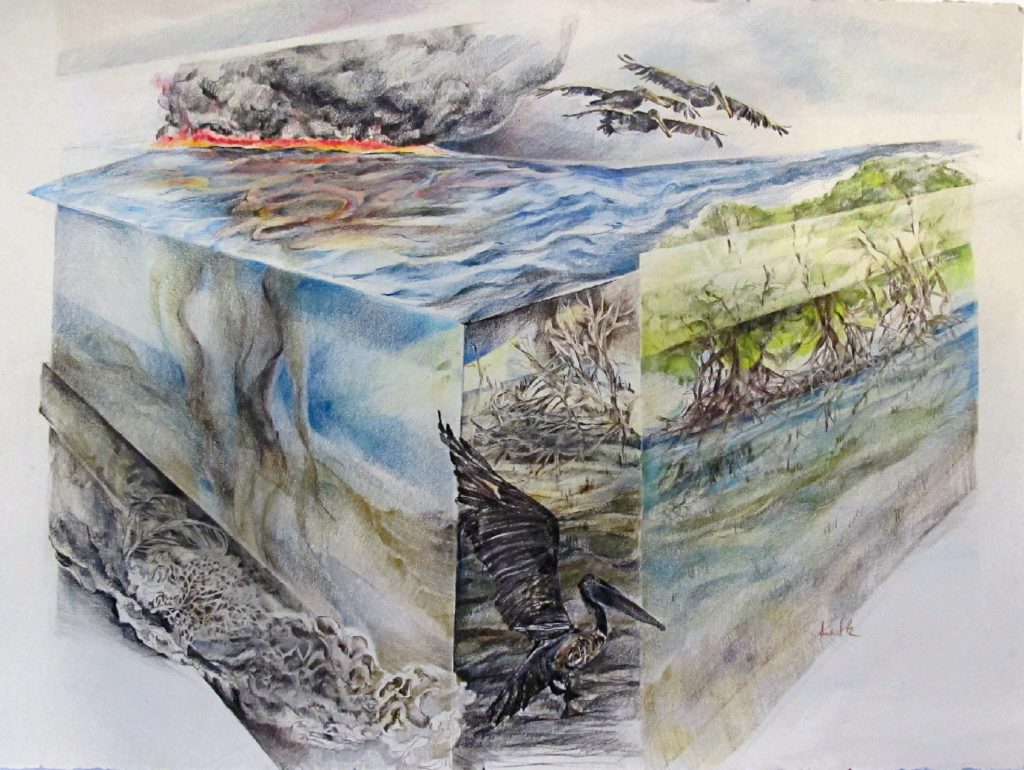
OIL SPILL, colored pencil, 2015.
Nature has always been a source of inspiration for me. All of my work reflects a profound appreciation for the environment. I strive to create art that is a poetic statement rather than literal depiction of my subject matter, even when I am drawn to creating representational landscapes near my home in rural Virginia.
In recent years, as wildfires flared across the globe, ocean levels rose, and ecosystems collapsed, I turned my artistic passion to depicting our climate crisis and using my work as a platform to raise awareness. The astronaut Edgar Mitchell described a profound shift in consciousness when he observed the earth from the distance of space, remarking on the planet’s fragility. Similarly, I developed a way of depicting the changes in the earth by borrowing from scientific cutaway diagrams of the earth’s mantle, to reduce the shifts in environmental degradation to miniature scale while also taking liberties in creating a relatively monumental scale of wildlife in the landscape.
I earned a BFA from the School of the Art Institute in Chicago, and a dual MA/MFA from Syracuse University. I have had solo exhibitions throughout Virginia, and group exhibitions along the east coast, New York and elsewhere. I retired from teaching at community colleges in Charlottesville Virginia, and now teach drawing and painting privately. I work as an exhibiting artist, illustrator and designer.
RUTH TABANCAY
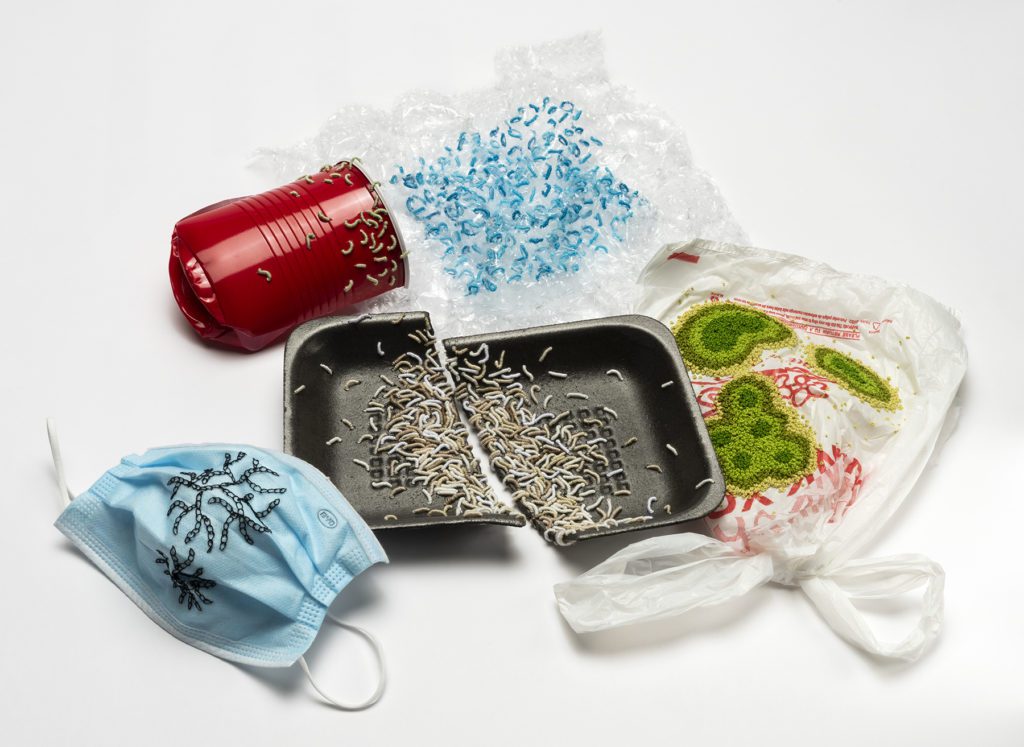
Adapting to New Substrates II, 2021. Various plastic materials, embroidery floss.
Imagining New Substrates is my fantasy that microorganisms and larvae will evolve to live on and digest various plastics -plastic bags, Styrofoam, bubble wrap, face masks, and plastic cups-that clog our environment. Certain embroidery stitches startlingly resemble bacteria, fungal structures, fungus colonies, and larvae, as seen through a microscope and in actual size. Researchers worldwide are working to cultivate bacteria whose enzymes break down plastic. Wax moth larvae have been found that eat plastic. Beetle larvae, known as superworms, have been shown to digest Styrofoam. It’s been shown in the laboratory that bacteria in cows’ stomachs can break down plastic. However, this research needs to advance further for these organisms to be available for the global scale needed to manage the increasing amounts of plastic accumulating on the planet.
WEAD MAGAZINE ISSUE No. 12, TAKING ACTION
Published October 2021
